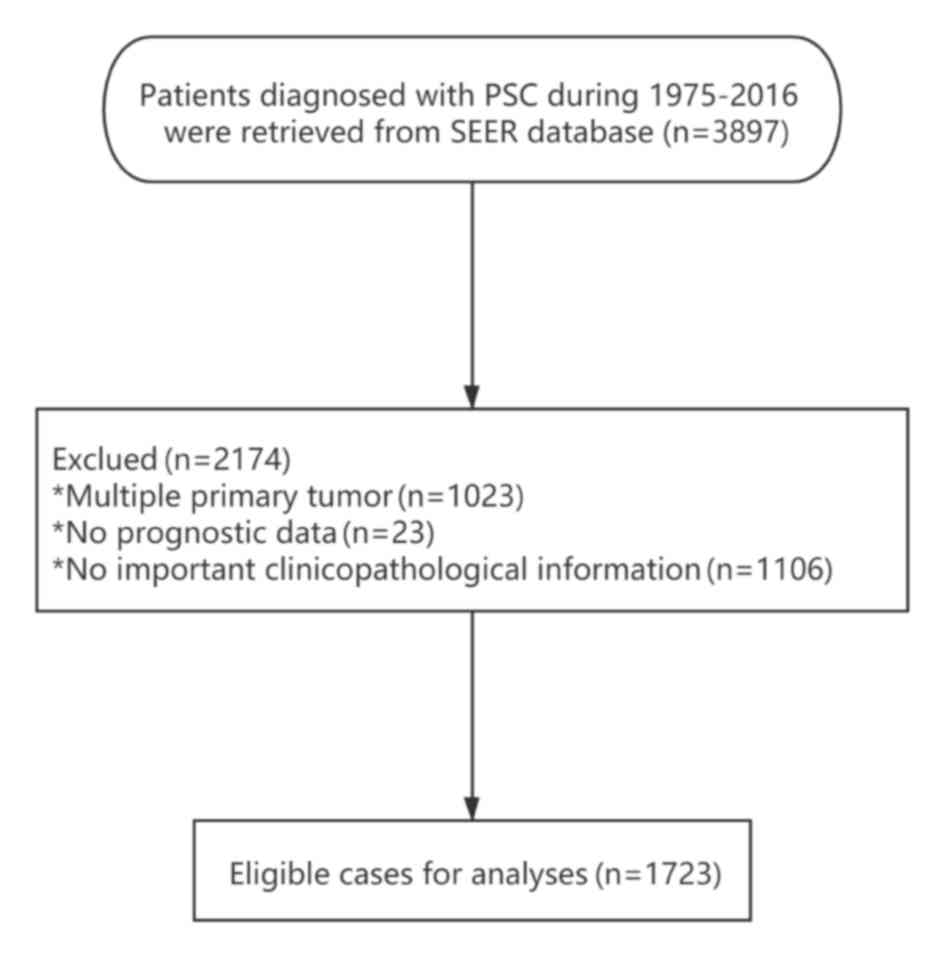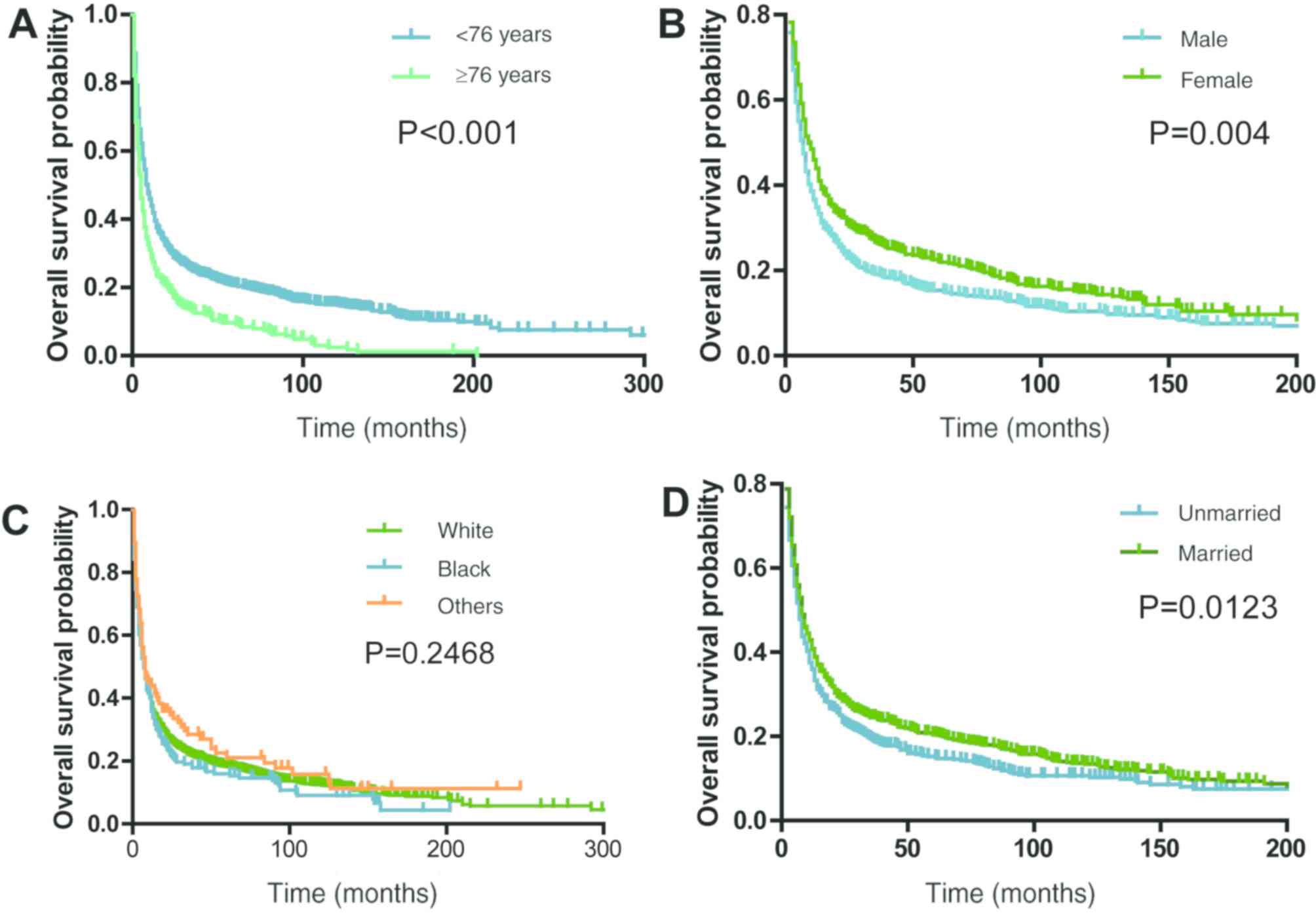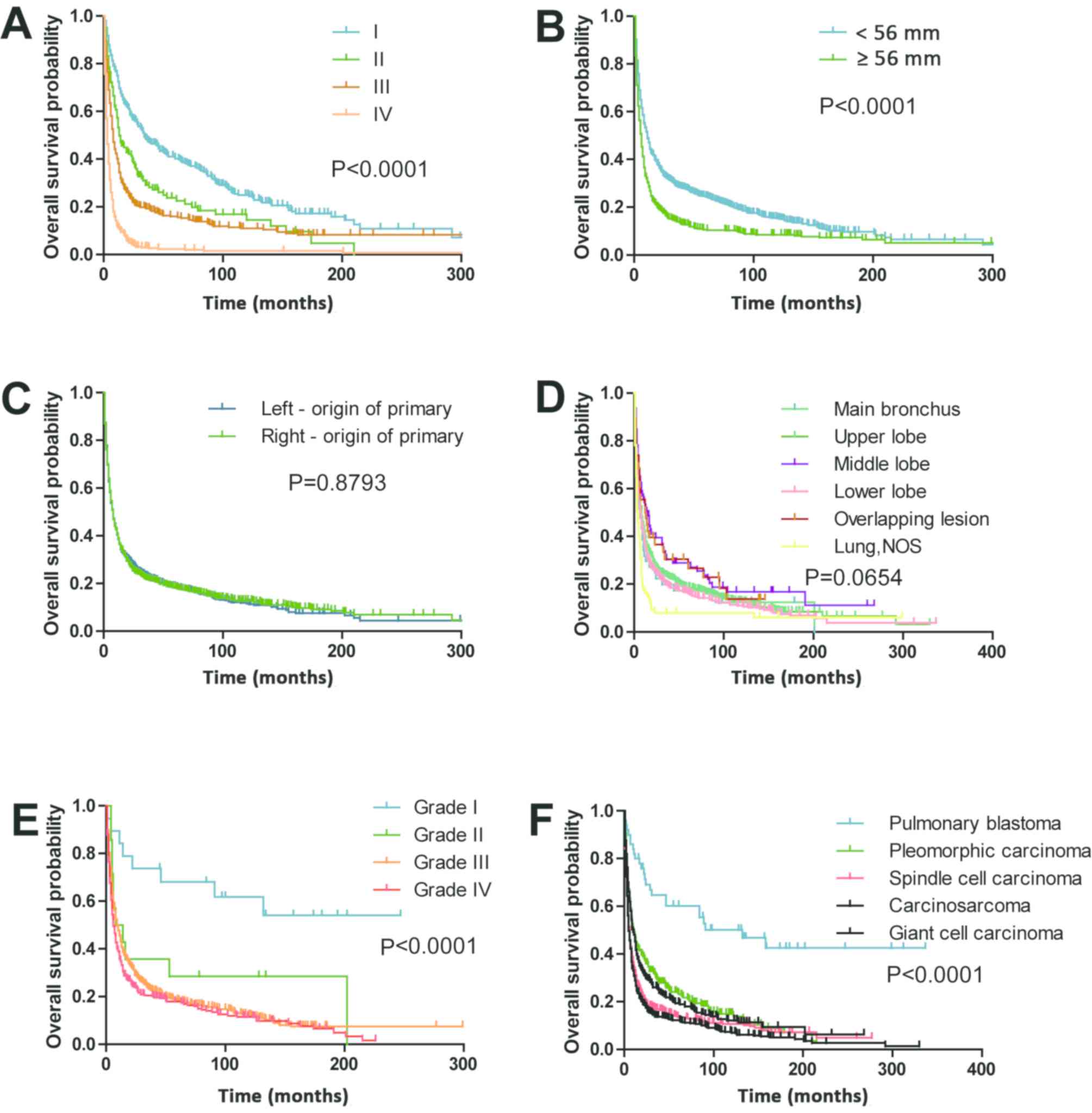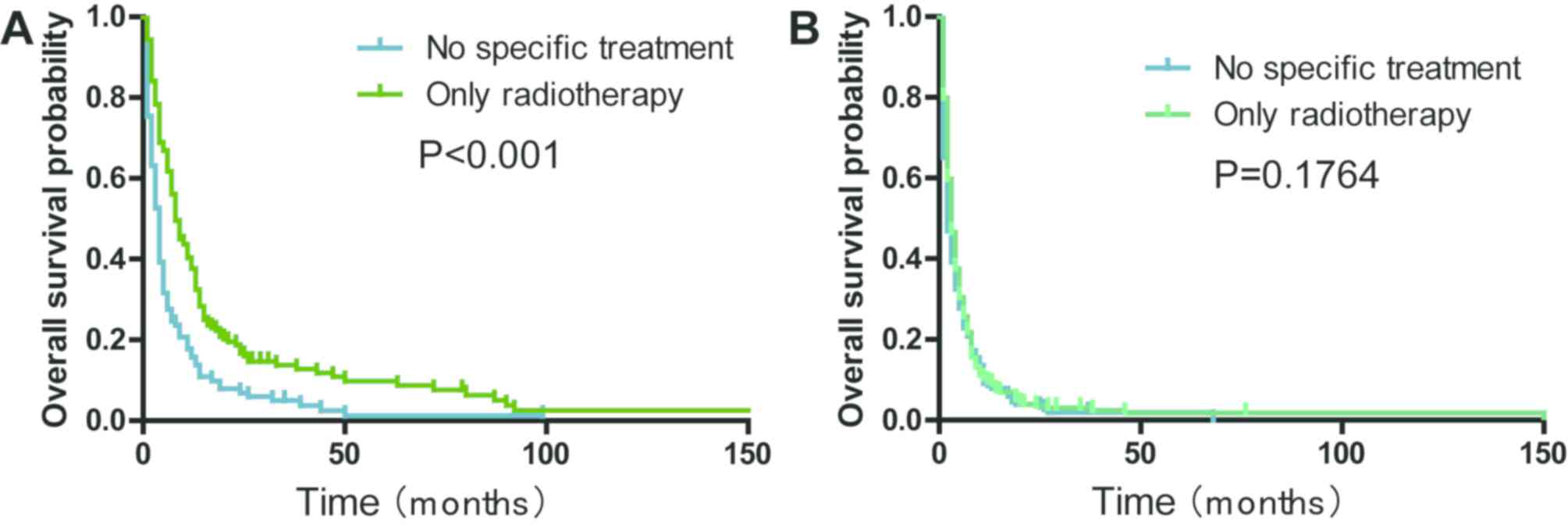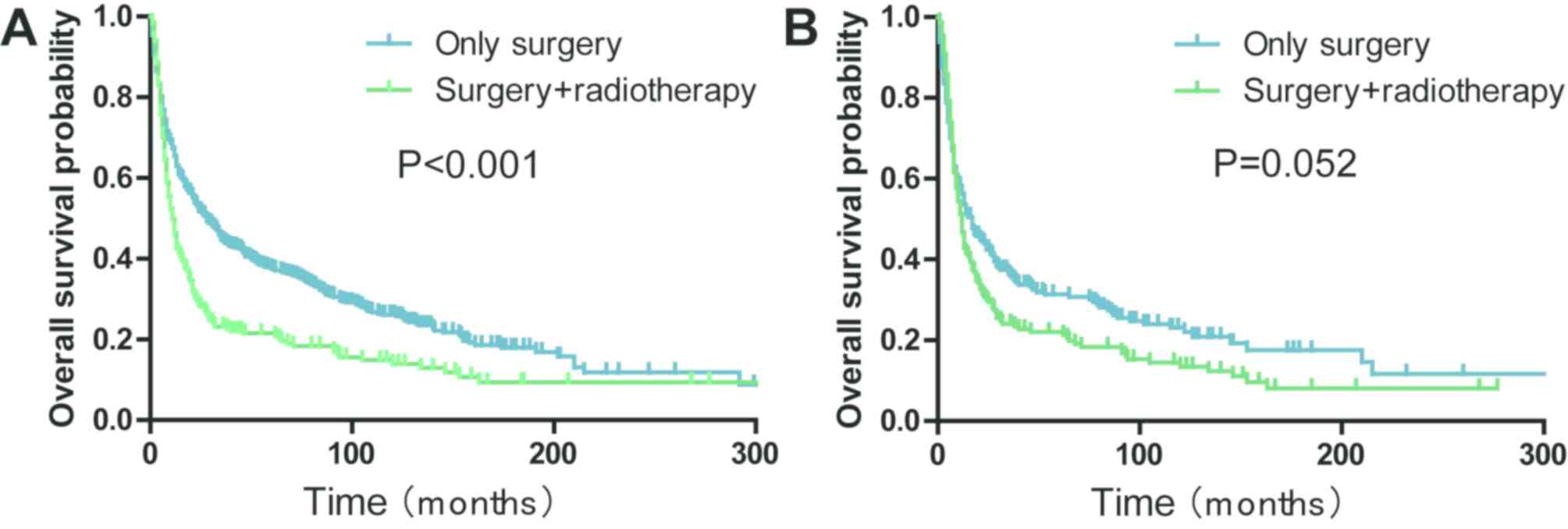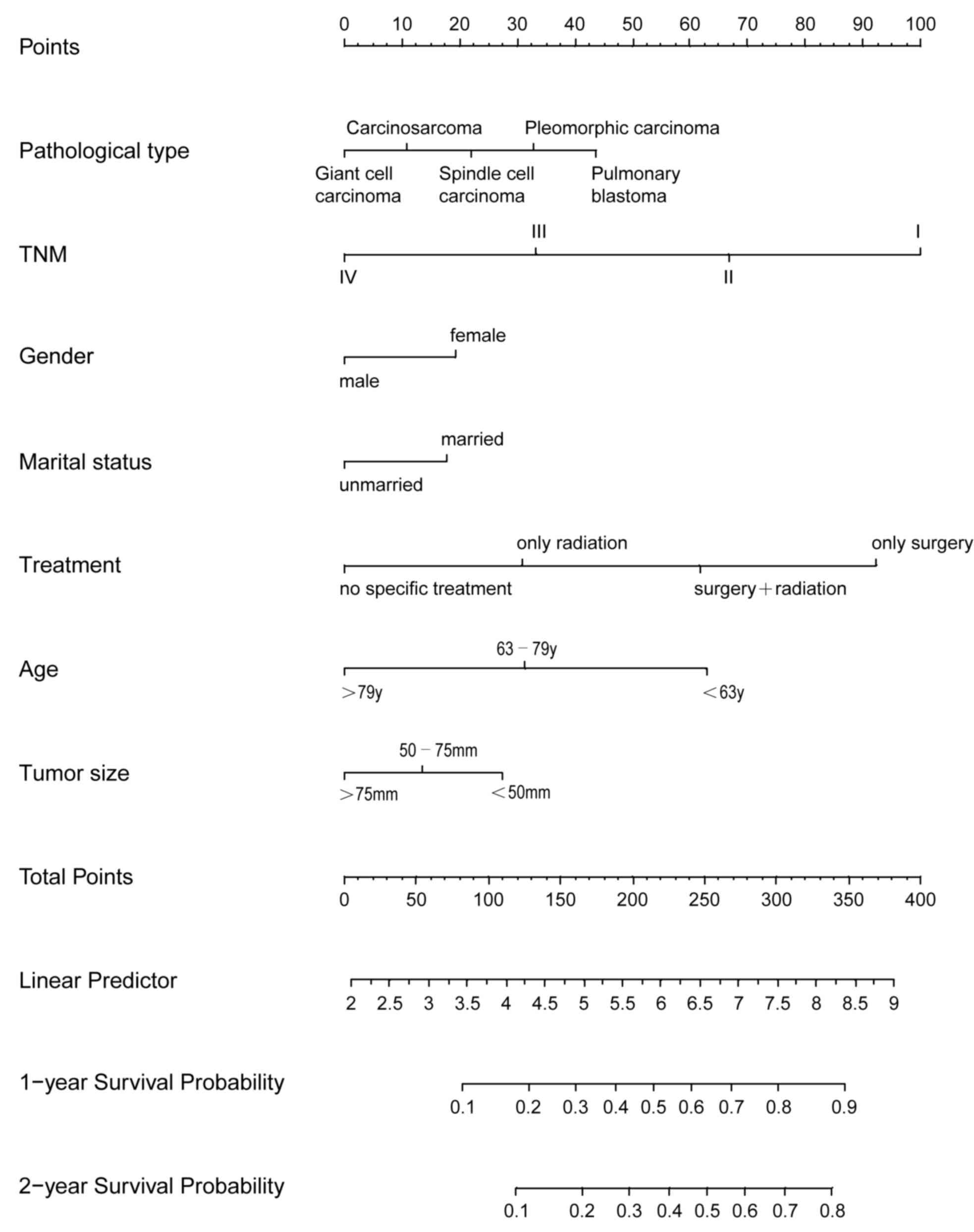|
1
|
Sim JK, Chung SM, Choi JH, Oh JY, Lee SH,
Kim JH, Min KH, Hur GY, Shim JJ, Kang KH, et al: Clinical and
molecular characteristics of pulmonary sarcomatoid carcinoma.
Korean J Intern Med. 33:737–744. 2018. View Article : Google Scholar : PubMed/NCBI
|
|
2
|
Yendamuri S, Caty L, Pine M, Adem S,
Bogner P, Miller A, Demmy TL, Groman A and Reid M: Outcomes of
sarcomatoid carcinoma of the lung: A Surveillance, Epidemiology,
and end results database analysis. Surgery. 152:397–402. 2012.
View Article : Google Scholar : PubMed/NCBI
|
|
3
|
Chaft JE, Sima CS, Ginsberg MS, Huang J,
Kris MG, Travis WD and Azzoli CG: Clinical outcomes with
perioperative chemotherapy in sarcomatoid carcinomas of the lung. J
Thorac Oncol. 7:1400–1405. 2012. View Article : Google Scholar : PubMed/NCBI
|
|
4
|
Yaguchi D, Ichikawa M, Ito M, Okamoto S,
Kimura H and Watanabe K: Dramatic response to nivolumab after local
radiotherapy in pulmonary pleomorphic carcinoma with rapid
progressive post-surgical recurrence. Thorac Cancer. 10:1263–1266.
2019. View Article : Google Scholar : PubMed/NCBI
|
|
5
|
Antoine M, Vieira T, Fallet V, Hamard C,
Duruisseaux M, Cadranel J and Wislez M: Pulmonary sarcomatoid
carcinoma. Ann Pathol. 36:44–54. 2016.(In French). View Article : Google Scholar : PubMed/NCBI
|
|
6
|
Steuer CE, Behera M, Liu Y, Fu C,
Gillespie TW, Saba NF, Shin DM, Pillai RN, Pakkala S, Owonikoko TK,
et al: Pulmonary sarcomatoid carcinoma: An analysis of the national
cancer data base. Clin Lung Cancer. 18:286–292. 2017. View Article : Google Scholar : PubMed/NCBI
|
|
7
|
Hendriksen BS, Hollenbeak CS, Reed MF and
Taylor MD: Perioperative chemotherapy is not associated with
improved survival in stage I pleomorphic lung cancer. J Thorac
Cardiovasc Surg. 158:581–591.e11. 2019. View Article : Google Scholar : PubMed/NCBI
|
|
8
|
Maneenil K, Xue Z, Liu M, Boland J, Wu F,
Stoddard SM, Molina J and Yang P: Sarcomatoid carcinoma of the
lung: The Mayo clinic experience in 127 patients. Clin Lung Cancer.
19:e323–e333. 2018. View Article : Google Scholar : PubMed/NCBI
|
|
9
|
Schrock AB, Li SD, Frampton GM, Suh J,
Braun E, Mehra R, Buck SC, Bufill JA, Peled N, Karim NA, et al:
Pulmonary sarcomatoid carcinomas commonly harbor either potentially
targetable genomic alterations or high tumor mutational burden as
observed by comprehensive genomic profiling. J Thorac Oncol.
12:932–942. 2017. View Article : Google Scholar : PubMed/NCBI
|
|
10
|
Rahouma M, Kamel M, Narula N, Nasar A,
Harrison S, Lee B, Stiles B, Altorki NK and Port JL: Pulmonary
sarcomatoid carcinoma: An analysis of a rare cancer from the
Surveillance, Epidemiology, and End Results database. Eur J
Cardiothorac Surg. 53:828–834. 2018. View Article : Google Scholar : PubMed/NCBI
|
|
11
|
Lewis JA, Petty WJ, Urbanic J, Bernstein
ED and Ahmed T: Cure of oligometastatic classic biphasic pulmonary
blastoma using aggressive Tri-modality treatment: Case series and
review of the literature. Cureus. 10:e35862018.PubMed/NCBI
|
|
12
|
Park JS, Lee Y, Han J, Kim HK, Choi YS,
Kim J, Shim YM and Kim K: Clinicopathologic outcomes of curative
resection for sarcomatoid carcinoma of the lung. Oncology.
81:206–213. 2011. View Article : Google Scholar : PubMed/NCBI
|
|
13
|
Lococo F, Rapicetta C, Cardillo G, Stefani
A, Margaritora S, Leuzzi G, Rossi G, Petracca Ciavarella L, Morandi
U, Facciolo F, et al: Pathologic findings and long-term results
after surgical treatment for pulmonary sarcomatoid tumors: A
multicenter analysis. Ann Thorac Surg. 103:1142–1150. 2017.
View Article : Google Scholar : PubMed/NCBI
|
|
14
|
Travis WD, Brambilla E, Nicholson AG,
Yatabe Y, Austin JHM, Beasley MB, Chirieac LR, Dacic S, Duhig E,
Flieder DB, et al: The 2015 World Health Organization
classification of lung tumors: Impact of genetic, clinical and
radiologic advances since the 2004 classification. J Thorac Oncol.
10:1243–1260. 2015. View Article : Google Scholar : PubMed/NCBI
|
|
15
|
NCI SEER, . Number of Persons by Race and
Hispanic Ethnicity for SEER Participants (2010 Census Data 1).
https://seer.cancer.gov/registries/data.htmlMarch
3–2020
|
|
16
|
NCI SEER, . Site Recode ICD-O-3/WHO 2008
Definition*^. https://seer.cancer.gov/siterecode/icdo3_dwhoheme/#footnotesMarch
3–2020
|
|
17
|
Ung M, Rouquette I, Filleron T, Taillandy
K, Brouchet L, Bennouna J, Delord JP, Milia J and Mazières J:
Characteristics and clinical outcomes of sarcomatoid carcinoma of
the lung. Clin Lung Cancer. 17:391–397. 2016. View Article : Google Scholar : PubMed/NCBI
|
|
18
|
Liang X, Li Q, Xu B, Hu S, Wang Q, Li Y,
Zong Y, Zhang S and Li C: Mutation landscape and tumor mutation
burden analysis of Chinese patients with pulmonary sarcomatoid
carcinomas. Int J Clin Oncol. 24:1061–1068. 2019. View Article : Google Scholar : PubMed/NCBI
|
|
19
|
Boland JM, Mansfield AS and Roden AC:
Pulmonary sarcomatoid carcinoma-a new hope. Ann Oncol.
28:1417–1418. 2017. View Article : Google Scholar : PubMed/NCBI
|
|
20
|
Basu A, Moreira AL, Simms A and Brandler
TC: Sarcomatoid carcinoma in cytology: Report of a rare entity
presenting in pleural and pericardial fluid preparations. Diagn
Cytopathol. 47:813–816. 2019.PubMed/NCBI
|
|
21
|
Franks TJ and Galvin JR: Sarcomatoid
carcinoma of the lung: Histologic criteria and common lesions in
the differential diagnosis. Arch Pathol Lab Med. 134:49–54.
2010.PubMed/NCBI
|
|
22
|
Yokoyama S, Murakami T, Tao H, Onoda H,
Hara A, Miyazaki R, Furukawa M, Hayashi M, Inokawa H, Okabe K and
Akagi Y: Tumor spread through air spaces identifies a distinct
subgroup with poor prognosis in surgically resected lung
pleomorphic carcinoma. Chest. 154:838–847. 2018. View Article : Google Scholar : PubMed/NCBI
|
|
23
|
Gu L, Xu Y, Chen Z, Pan Y and Lu S:
Clinical analysis of 95 cases of pulmonary sarcomatoid carcinoma.
Biomed Pharmacother. 76:134–110. 2015. View Article : Google Scholar : PubMed/NCBI
|
|
24
|
Yin J, Yang Y, Ma K, Yang X, Lu T, Wang S,
Shi Y, Zhan C, Zhu Y and Wang Q: Clinicopathological
characteristics and prognosis of pulmonary pleomorphic carcinoma: A
population--based retrospective study using SEER data. J Thorac
Dis. 10:4262–4273. 2018. View Article : Google Scholar : PubMed/NCBI
|
|
25
|
Weissferdt A, Kalhor N, Rodriguez Canales
J, Fujimoto J, Wistuba II and Moran CA: Spindle cell and
pleomorphic (‘sarcomatoid’) carcinomas of the lung: An
immunohistochemical analysis of 86 cases. Hum Pathol. 59:1–9. 2017.
View Article : Google Scholar : PubMed/NCBI
|
|
26
|
Weng SS, Cao Y, Tang XJ, Zhu LZ, Tan YN,
Dong CX, Chen JQ, Shen H and Yuan Y: Epidemiological features of
lung giant cell carcinoma and therapy for patients with EGFR
mutations based on case reports and the surveillance, epidemiology,
and end results (SEER) database. Oncotarget. 8:25323–25333. 2017.
View Article : Google Scholar : PubMed/NCBI
|
|
27
|
Hong JY, Choi MK, Uhm JE, Park MJ, Lee J,
Park YH, Ahn JS, Park K, Han JH and Ahn MJ: The role of palliative
chemotherapy for advanced pulmonary pleomorphic carcinoma. Med
Oncol. 26:287–291. 2009. View Article : Google Scholar : PubMed/NCBI
|
|
28
|
Ettinger DS, Wood DE, Aisner DL, Akerley
W, Bauman J, Chirieac LR, D'Amico TA, DeCamp MM, Dilling TJ,
Dobelbower M, et al: Non-small cell lung cancer, version 5.2017,
NCCN clinical practice guidelines in oncology. J Natl Compr Canc
Netw. 15:504–535. 2017. View Article : Google Scholar : PubMed/NCBI
|
|
29
|
Nakayama S, Sasaki M, Morinaga S and
Minematsu N: Nonsmall cell lung carcinoma with giant cell features
expressing programmed Death-ligand 1: A report of a patient
successfully treated with pembrolizumab. Case Rep Oncol Med.
2018:58630152018.PubMed/NCBI
|
|
30
|
Wei W, Zhou J, Zhang Q, Liao DH, Liu QD,
Zhong BL, Liang ZB, Zhang YC, Jiang R, Liu GY, et al: Postoperative
intensity-modulated radiation therapy reduces local recurrence and
improves overall survival in III-N2 non-small-cell lung cancer: A
single-center, retrospective study. Cancer Med. Feb 26–2020.doi:
10.1002/cam4.2937 (Epub ahead of print). View Article : Google Scholar
|
|
31
|
Qin BD, Jiao XD, Liu K, Wu Y, He X, Liu J
and Zang YS: Clinical, pathological and treatment factors
associated with the survival of patients with primary pulmonary
salivary gland-type tumors. Lung Cancer. 126:174–181. 2018.
View Article : Google Scholar : PubMed/NCBI
|
|
32
|
Yang H, Lin Y and Liang Y: Treatment of
lung carcinosarcoma and other rare histologic subtypes of non-small
cell lung cancer. Curr Treat Options Oncol. 18:542017. View Article : Google Scholar : PubMed/NCBI
|















